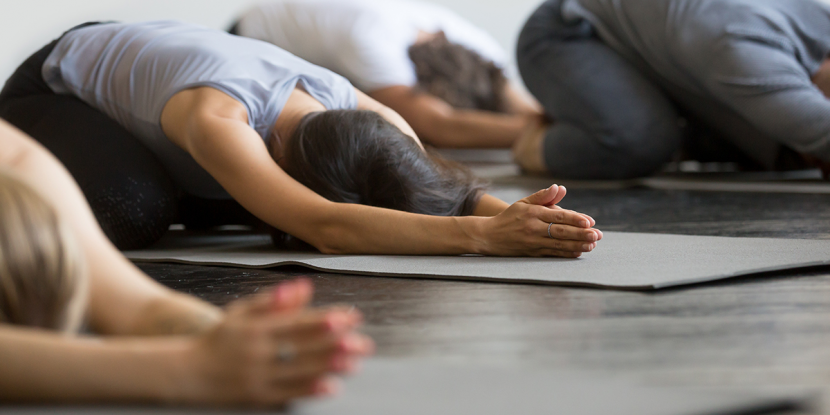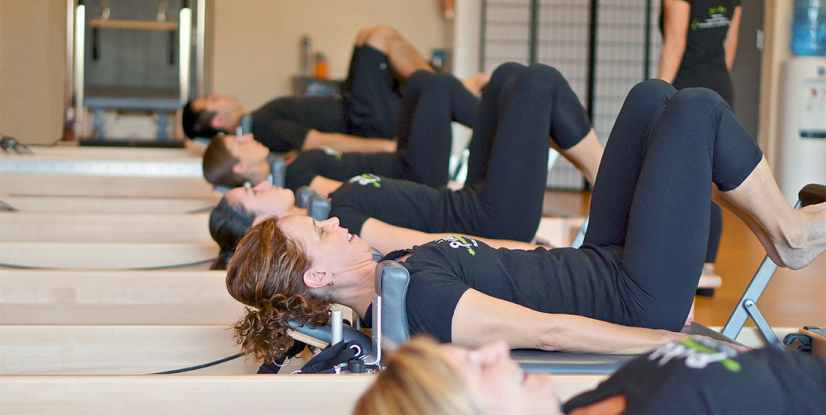Fitness is the ability to perform activities of daily living without getting tired. Physical fitness is a weapon against many diseases and in present-day life, one should be formidably armed to fight against the conditions that can compromise the quality of life. Over time, a sudden hike is witnessed in the mortality ratio possibly due to a sedentary lifestyle and emotional turmoil experienced on daily basis. Seeing an increased disease rate, the fitness industry flourished tremendously with diverse fitness trends with new crazes being marketed to satisfy clients’ fitness and aesthetic needs. Throughout this period yoga and Pilates gained immense popularity due to their profound benefits for physical as well as mental health. These are low-impact exercises that challenge the physical and mental capacities of a person and help him acquire strength in both aspects.
What is Yoga?
Yoga is an ancient practice to improve overall health by connecting body, mind, and spirit. It has been exercised as a spiritual practice for thousands of years and it finds its origin in the Vedas, the oldest religious texts of Hindus. Yoga emphasizes physical posture (asanas), breathing techniques (pranayamas), and meditation (Dyana). Yoga is widely used not just in the East but in Western culture to achieve perfect mind and body alignment. It is a therapeutic tool to treat physical and mental conditions.

Read More: Working out in the afternoon or evening may help control Blood sugar – About Pakistan
Types of Yoga
Different types of yoga target specific health issues. It can be used to treat back pain, reduce belly fat, weight loss, or even weight gain. Despite having specific health benefits, different practices of yoga focus on a common goal which is overall well-being and improved physical health. The following are the types of yoga:
Hatha yoga:
The word Hatha comes from Sanskrit, which means “force”. It focuses on the restoration of the balance of the body and creates harmony between chakras and energy points. Chakras are the vortexes of energy or the points where the energy is concentrated. These points are located in seven different locations in the body and connect to different organs and glands.
There are different physical postures of Hatha yoga, which balance the body and mind.
Ashtanga yoga:
An ashtanga is a famous form of yoga for weight loss. Ashtanga is derived from Sanskrit meaning eight. There are eight different pillars of Ashtanga: Principles, personal discipline, asana and postures, pranayama, withdrawal, concentration, meditation, and salvation.
Ashtanga yoga is best to treat upper and lower back pain, stress, and anxiety and to promote fat loss.
Kundalini yoga:
Kundalini yoga is about releasing the kundalini energy from the base of the spine which is believed to be coiled like a snake in the lower spine. It is practiced to get relief from stress, anxiety, and depression and to improve cognitive functioning. Kundalini yoga involves chanting, singing, breathing exercises, and repetitive poses. It is also called “yoga of awareness “.
Vinyasa yoga:
The word Vinyasa has two parts Vi means variations and Nyasa which means within prescribed limits. It incorporates breathing techniques and movements. It creates a flow of postures with controlled breathing mimicking the flow of life. For example, it starts with a child’s pose and ends with a death pose. Meditation is an advanced form of Vinyasa yoga making the practice more mindful. Some of the famous postures of Vinyasa yoga are planks, knee-to-chest chin pose, downward-facing dog pose, and cobra pose. It is suitable for people with anxiety, depression, blood pressure, and sleep.
Read More: Keto Diet vs Atkins Diet: How They Are Similar And Different? – About Pakistan
Lyengar yoga:
Lyengar yoga got its name from B.K.S Iyengar, one of the foremost yoga teachers in the world. It focuses on the postures, body alignment, and opening of the body. It is believed to treat musculoskeletal disorders as well as gynecological and gastroenterological problems. It has shown visible results in treating disabilities of the spine. It also uses props such as yoga blocks and yoga belts. It has numerous health benefits including improving flexibility, muscle strengthening, Improved breathing, a calmer mind, pain relief, and improved posture and alignment.
Aerial yoga:
It is different from traditional yoga as it incorporates other exercises such as running and swimming all while defying gravity. It helps to build toned muscles. In this particular type of yoga, a rope suspends the body in the air, and poses are introduced hereafter. It helps cure breathing diseases, provides core stability, improves posture, and provides relief from stress.
Restorative yoga:
This type of yoga mainly relaxes the nervous system and it is a great form to remove stress from the nervous system. Restorative yoga is based on guided meditation and it is completed in various poses. The idea is to hold the poses for a few minutes.
Prenatal yoga:
Prenatal yoga, as the name suggests focuses on the pains associated with pregnancy and labor. It educates pregnant females about various breathing techniques that could be helpful during pregnancy and even in the postnatal period. This form also helps new mothers to lose some weight following childbirth.
Benefits of Yoga:
Yoga is a popular practice worldwide to improve physical, mental, and spiritual health. Different poses of yoga can help in treating chronic conditions and eradicate the cause. Some common benefits of yoga include increased flexibility, Improved muscle strength, and tone, improved breathing, weight reduction, maintaining balanced homeostasis, improved athletic performance, stress management, and dealing with mental conditions such as depression and mood liability. The Health benefits of yoga cannot be undermined as it not only focuses on the physical aspect of health, but also the mental aspect by incorporating meditation that promotes self-awareness in a person.
Read More: The Science of Weight Loss – About Pakistan
What is Pilates?
Pilates is a form of low-impact exercise and body conditioning that focuses mainly on the core muscles. It was developed by Joseph Pilates in the early 20th century, mostly as an injury recovery method for dancers. It aims to strengthen muscles and increase flexibility. When we say core it includes the entire trunk that is abdominal, the hips, the inner and outer thighs, and the back. Pilates can be done with or without equipment, but the movements should be slow, sustained, and with precise breathing control. It tends to target the core, but exercises also work on the other areas of the body. Pilates can help to cure back pain as strengthening the core develops stability throughout the torso so this is how it alleviates back pain.

Principle of Pilates :
There are six basic principles of pilates
Centering:
It involves making a person aware of the center of the body -the area between the lower ribs and the pubic bones. This central region of the core is the focus of the Pilates exercises.
Concentration:
By concentrating fully on each movement better results would be born from each exercise.
Control :
Complete muscular control requires conscious, deliberate movements and is emphasized in every pilates e exercise.
Precision :
Precision comes when each movement is performed with Complete focus placement of each body part and proper body alignment and core engagement.
Breath:
Breath control is an integral part of the Pilates exercises breathing through the lungs to encourage the proper in and out movement of the air is necessary. Pilates exercises coordinate with the breathing pattern to make it more effective.
Flow:
Pilates exercises should not be rigid, instead, they should be flexible and easy to perform. Care should be taken that exercises should be concentrated around the core muscles and should connect each part of the body to move in a single fluid motion.
Types of Pilates:
Pilates is divided into two categories; exercises that use special equipment and mat exercises
Equipment Pilates (apparatus):
Pilate equipment is more commonly referred to as apparatus. There are large apparatuses that are available at the gym or Pilates
Studio such as reformers, towers that are attached to reformers in a studio, Cadillac also known as trap table, Pilates chair or ladder barrel, and then the small apparatus that can be bought and easily used at home such as resistance bands, therapy ball, tennis ball, Pilates ring, foam roller, exercise ball.
Mat Pilates:
Pilates can be performed at home on a Pilates mat which is not the same as a yoga mat. A Pilates mat is longer, thicker, denser, and tends to have a slicker surface. Some Pilates exercises are done either on the mat or directly on the floor.
Read More: Bland Diet: What To Eat And What To Avoid? – About Pakistan
Benefits of Pilates:
Pilates creates long, strong, and toned muscles due to eccentric contractions of the core muscles. Strengthening of the core muscles, promotes the overall well-being of the body. It enhances flexibility, endurance, and agility. Pilates help improves the postural alignment and efficiency in movement through activities of daily living. It serves the restorative function for the muscles that are damaged as during pregnancy the pelvic floor muscles become weak and core stability is compromised as a result of the lower cross syndrome. Pilates can help deal with musculoskeletal disorders when incorporated into a daily routine and practiced regularly.
Yoga vs Pilates:
Both yoga and Pilates are low-impact exercises that focus on coordination between proper breathing and precise movements and help gain flexibility and mental focus. Yoga and Pilates focus on deep breathing or diaphragmatic breathing to work on circulation. But the major element that makes Pilates different from yoga is that the former is an ancient spiritual practice of connecting the body, mind, and breathing while Pilates is a group of exercises that emphasizes the engagement of core muscles to promote the functional movement of the body.
What is the right choice for you?
The choice between yoga and Pilates is entirely based on the goals of an individual. If a person wants to gain strength and flexibility, Pilates might be a better choice similarly if a person is looking for an option that could help him improve his overall wellness, including both physical and mental well-being, yoga can be the right choice in this case.
Read More: Natural Remedies For Reducing Anxiety and Stress – About Pakistan
To summarize, whichever exercise regime is followed, the only way to get the results is by working out regularly thus, consistency is the key to achieving the desired health goals.


















